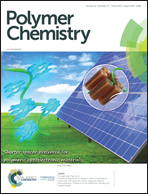Oxidation-responsive polyether block copolymers lead to non-ionic polymer surfactants with multiple amine N-oxides†
Abstract
Block copolymers consisting of a nonpolar poly(propylene oxide) block and a poly(glycidyl amine) block were prepared by anionic ring-opening polymerization (AROP). The tertiary amine groups of the block copolymers were quantitively transformed into the corresponding zwitterionic amine N-oxides, as confirmed by 1H NMR and 15N NMR spectroscopy. This leads to strongly amphiphilic polyether block copolymers with multiple N-oxides. Full oxidation of the amine groups was also possible in situ in an emulsion, demonstrating the oxidation-responsive character of this new class of non-ionic polymeric surfactants.



 Please wait while we load your content...
Please wait while we load your content...